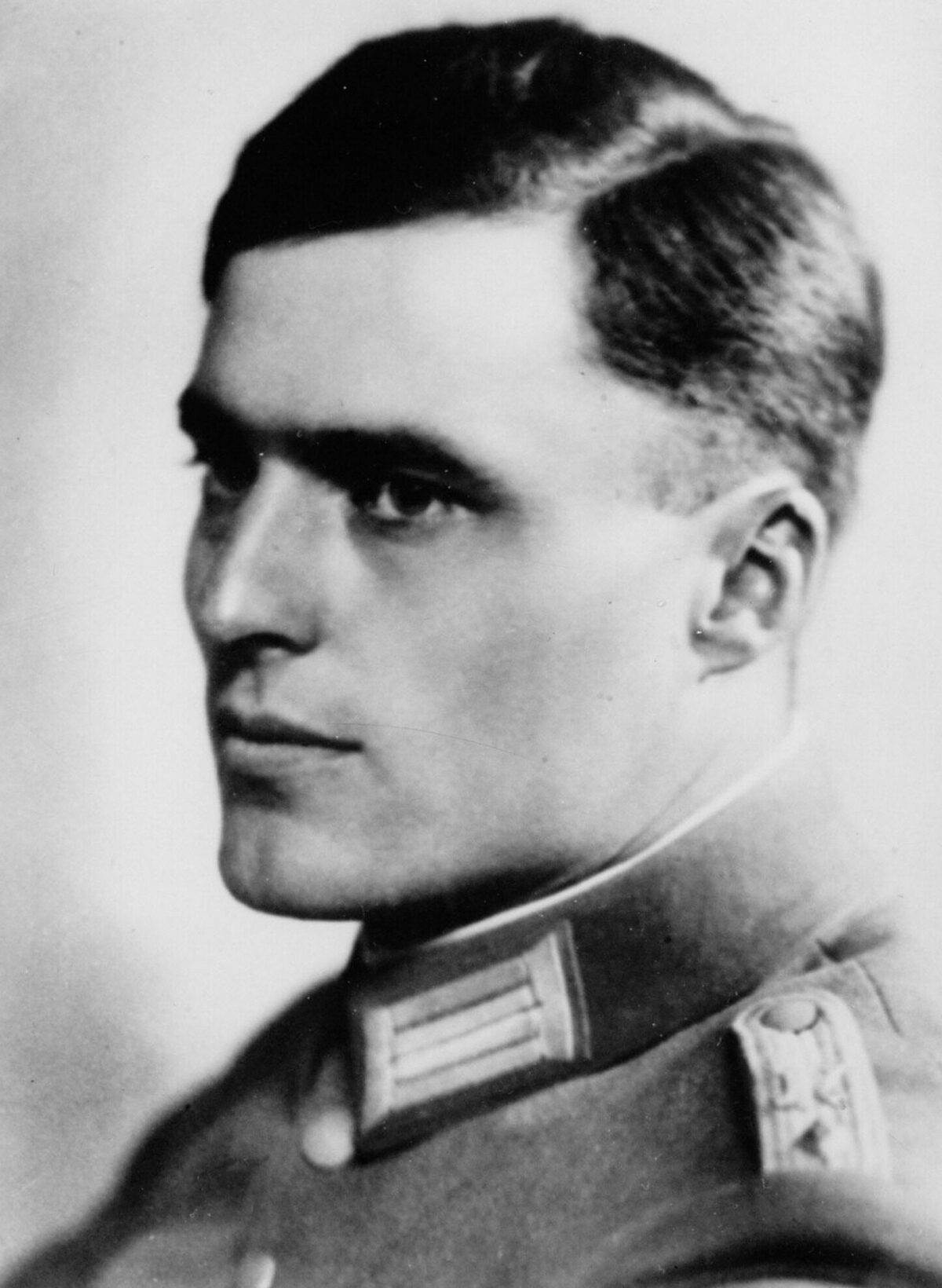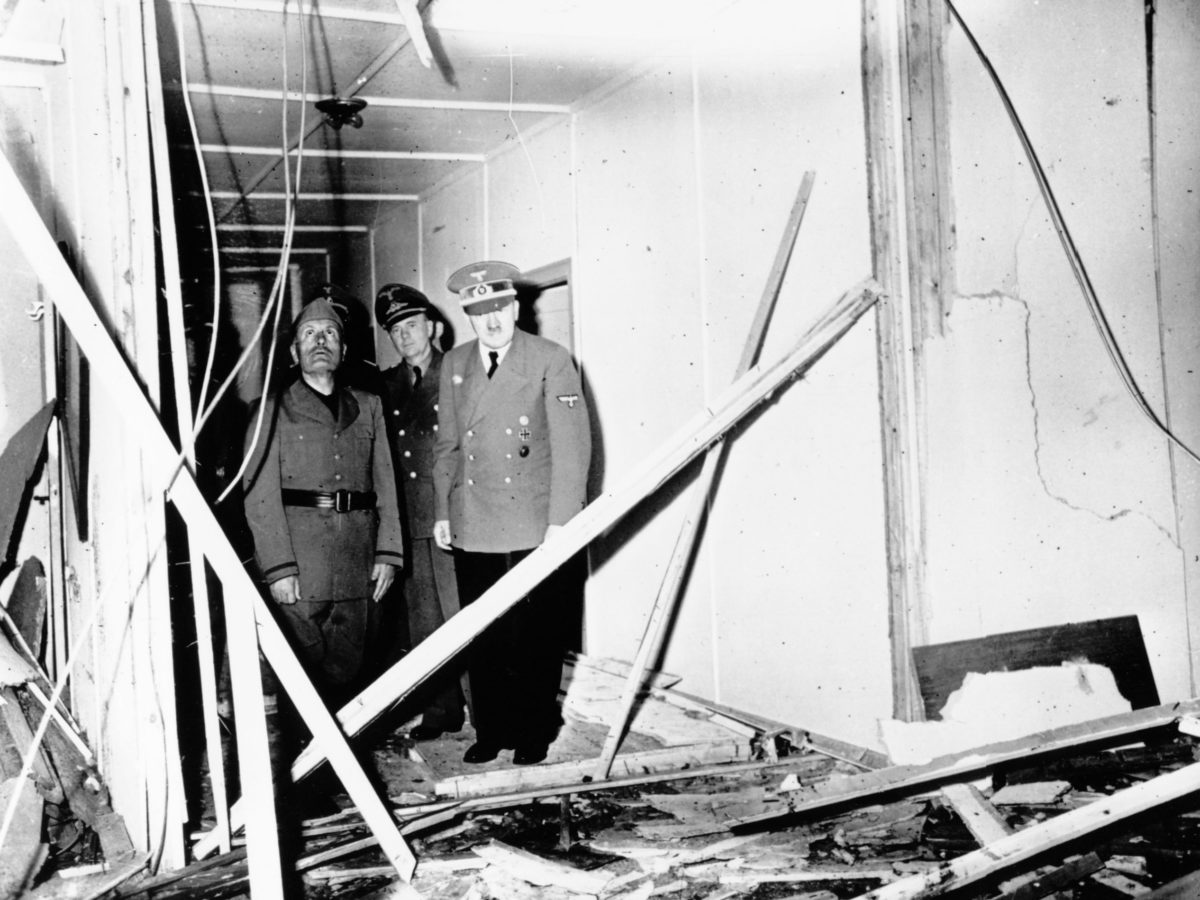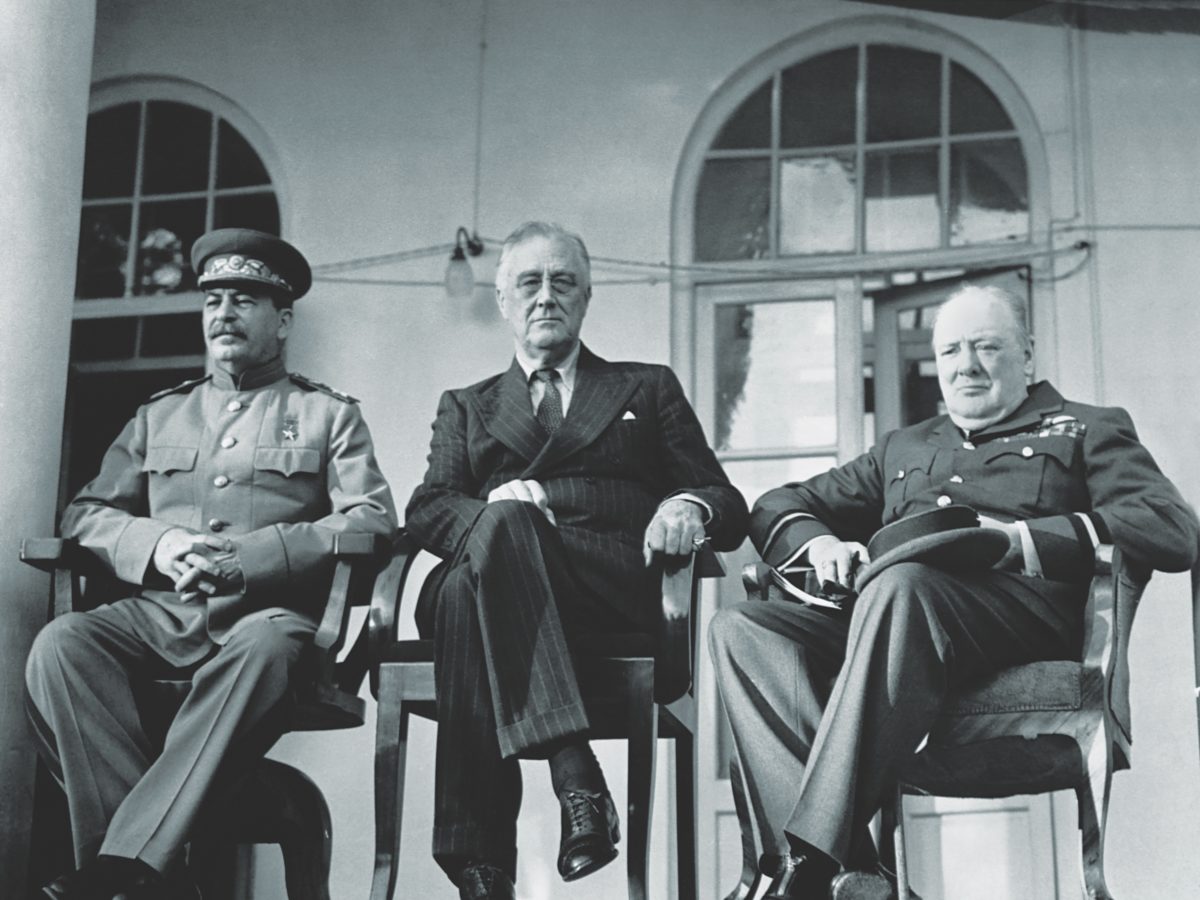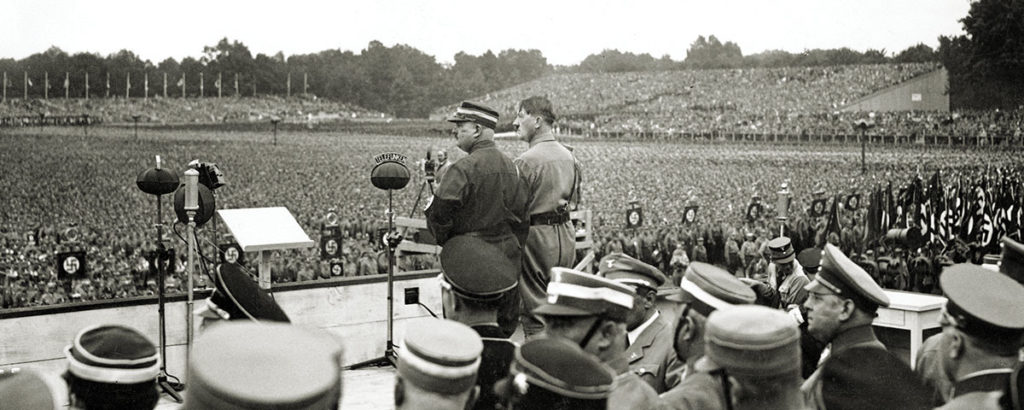July 20, 1944, found the Stauffenberg family gathered, as they had so many summers before, at their rambling country house in the village of Lautlingen, in the rolling Swabian Alps of southern Germany. With the war in its fifth year and taking an increasingly ominous turn for Germany, most of the adult male members of the aristocratic Catholic clan—twins Alexander and Berthold, and their brilliant younger brother Claus—were absent. Presiding over the household of six boisterous children were Claus’s wife, Nina; the children’s grandmother, Caroline, and their great-aunt Alexandrine; and their great-uncle Nikolaus Üxküll, known to all as “Uncle Nux.” Only he knew that their lives were about to be shattered.
“By then the war was getting uncomfortably close,” Claus’s eldest son, Berthold, recalled in a recent interview—which made the escape from their house in Bamberg, some 130 miles to the northeast, especially welcome. “Even in that provincial backwater there were constant air raids and raid alarms, and I had to sit my school exams in an underground shelter. The continual memorial services for those who had fallen at the front—at which I often served as a Catholic altar boy—were another grim reminder of the war. Nevertheless, Nazi control was still absolute. We were fed a constant diet of propaganda promising us Endsieg, or ‘final victory,’ in the state-controlled press and radio, which I naturally believed.”
GET HISTORY’S GREATEST TALES—RIGHT IN YOUR INBOX
Subscribe to our HistoryNet Now! newsletter for the best of the past, delivered every Monday and Thursday.
So keen a young Nazi was the then-10-year-old boy that he was bitterly disappointed to be just three days too young to join that year’s intake of the Jungvolk, the junior branch of the Hitler Youth. “My dearest wish was to march through Bamberg carrying a Nazi banner at the head of a youth parade,” said Berthold. “Fortunately my mother who, unknown to me, shared my father’s anti-Nazi views, prevented this.”
Berthold’s father, Claus Schenk, Count von Stauffenberg—a religious man with a philosophic bent, an accomplished horseman, and a lover of poetry—was about to become infamous for those anti-Nazi views. At about the same time his family was sitting down to lunch at Lautlingen on that sweltering July day, Stauffenberg was placing a bomb, hidden inside his briefcase, under a conference table at Wolfschanze (“Wolf’s Lair”), Hitler’s headquarters in East Prussia, in an attempt to assassinate the führer and overthrow his regime. Stauffenberg came within a hair’s breadth of accomplishing his goal when the bomb exploded at approximately 12:40 p.m., demolishing the room and killing three officers and a secretary. But Hitler was merely wounded—and it was the Stauffenberg family instead that was torn apart in the aftermath of the attempted coup.
CHILD OF NAZISM
Young Berthold had not seen much of his father since the war began. Thirty-six-year-old Colonel von Stauffenberg was a popular and able career soldier, singled out by his superiors for a glittering future. He had served as a staff officer in the conquest of Poland in 1939, the invasion of France in 1940, and the campaign against Russia in 1941. Initially Stauffenberg gave the prewar Hitler regime the benefit of the doubt. But from 1942 onward, that changed dramatically. Nauseated by the mass murder of Jews and the treatment of civilian populations on the eastern front, and by Hitler’s insatiable appetite for war and his reckless military incompetence, Stauffenberg joined fellow officers in actively conspiring against Nazi rule.
In early 1943, Stauffenberg was posted to Tunisia as senior staff officer to the 10th Panzer Division for the last days of the North African campaign. Rommel’s once-vaunted Afrika Korps was now penned in against the sea, trapped by the Americans advancing from the west and the British from the east. The fighting was intense, and in April Stauffenberg was seriously wounded when an American aircraft strafed his Horch staff car. One officer in the back seat was killed and Stauffenberg, whose body was pitted with shrapnel, lost his left eye, his right hand, and two fingers on his left hand. Evacuated to Munich, he astonished doctors with the speed of his recovery. Within weeks he had learned to dress himself using his teeth and his three remaining fingers. His performance was so dexterous that he joked he didn’t know what he had ever used his other seven fingers for.
In the summer of 1943, Stauffenberg joined his family at Lautlingen for a prolonged convalescence. Once he returned to his duties that fall, the conspiracy took on momentum as his fellow plotters got him assigned to a staff position with the Ersatzheer, or Replacement Army, headquartered in Berlin. There, he directed revisions to Replacement Army mobilization orders, code-named “Valkyrie,” as cover for a military putsch that would use its troops to overthrow the regime in the confusion following a successful assassination of Hitler.
DECIDING TO KILL HITLER
The decision to topple Hitler weighed heavily on Stauffenberg. Was it right, he asked a relative in mid-1943, to sacrifice the salvation of one’s own soul if one might thereby save thousands of lives? He concluded that it was not only right, but imperative. Around that same time, he told several people, including Margarethe von Oven, a Replacement Army secretary who typed the orders he drafted, that he was consciously “committing high treason.” He added that, faced with such an evil regime, he had had to choose between action and inaction, and as an active Christian there could only be one decision.
In June 1944, Stauffenberg was named Replacement Army chief of staff. This was a key post, giving him regular access to Hitler at the führer’s military conferences. As Germany’s military situation steadily worsened, Stauffenberg worked to perfect the plot and overturn the regime in time to prevent a Soviet invasion of Germany. Able, energetic, and charismatic, he became the head, heart, and guiding hand of the conspiracy.
Berthold saw his father just three times after he joined the Replacement Army: for two days at Christmas; in January at the funeral of Berthold’s maternal grandfather; and for a week’s leave in June 1944, which coincided with the Allied invasion of Normandy. Despite Germany’s increasingly precarious position, Berthold maintained his boyish belief in final victory—placing his faith in the V-1 flying bombs and V-2 rockets designed by Wernher von Braun and raining down on Britain even as the Allied armies closed in on the Reich.
“Naturally,” Berthold recently recalled, “I had absolutely no idea what my father was planning and preparing, nor did I realize how much my mother knew of his views.” For reasons of security, neither she nor anyone else in the family, save Uncle Nux and Claus’s brother Berthold—a fellow participant in the plot—were aware of Stauffenberg’s precise plans to kill Hitler. But she knew of and shared her husband’s disgust with the increasingly criminal Nazi regime, and had to carefully conceal her opinions. “The papers were full of the dire fate of those who listened to foreign radio stations, traded on the black market, or spread defeatist rumors,” said Berthold. “Such cases usually ended in a death sentence.”
Recommended for you
BOMB PLOT
In mid-1944 the situation looked increasingly grim and by mid-July, Stauffenberg was en route to Wolfschanze. In his briefcase he carried a bomb composed of plastic high explosive, which he had decided—despite his crippling injuries—to prime and detonate himself at the earliest opportunity. Only his closest confederates in the conspiracy knew this. He had asked Nina to delay her departure to Lautlingen so that he might first speak with her, likely for the last time. But he couldn’t reveal the reason, and she had already made travel arrangements, so on July 18, she and the children left Bamberg for Lautlingen.
There was quite a gathering that summer at the old family seat, where Claus and his brothers had spent idyllic childhood vacations before the First World War. Claus’s four children—Berthold and his three younger siblings: brothers Heimaren and Franz-Ludwig, aged eight and six, and sister Valerie, aged three—joined their two cousins, the five- and six-year-old children of their uncle Berthold.
Claus’s eldest son recalled with precise clarity how he learned of the event that shattered his family’s lives. “On 21st July I heard a radio report of a ‘criminal attack on the führer,’” Berthold said. “But my questions about this were evaded, and the adults tried to keep me and my next youngest brother Heimaren away from the radio.
“Instead, we children were taken for a long country walk by our great-uncle Nux—a former general staff officer in the Austrian Imperial Army—who kept us entertained with stories of his youthful adventures as a big-game hunter in Africa,” said Berthold. “Naturally, none of us knew that he, too, was a member of the anti-Hitler conspiracy. Today, I still ask myself what thoughts were going through his head during that walk.” Uncle Nux would be tried and hanged a few weeks later for his part in the plot.
The following day, Nina took her two eldest sons aside and gently told them that it was their father who had attempted to assassinate Hitler. She also revealed that he had been executed by firing squad late that same day, after the failure of his desperate attempts to launch the Valkyrie putsch in the wake of the bombing. Finally, as if all this was not enough, she told the boys that she was expecting her fifth child.
“Our world split apart at a stroke,” Berthold said. “When I asked in perplexity why my father had wanted to kill the Führer, my mother answered that he had believed that he had to do it for Germany’s sake.
“The news of the bomb attack came as a thunderbolt. Not only did we love our always-cheerful father above all things; he was also the absolute authority over our lives—even if he was often absent soldiering. The shock was so profound that I believe I was unable to think clearly about anything from that moment until the end of the war. Actually, there was no time for thinking at all because from then on the blows started to fall on us thick and fast.”
PUNISHING THE STAUFFENBERG FAMILY
That night, the Gestapo arrested Nina and Uncle Nux and took them to Berlin. The following night, even Claus’s aging mother and aunt Alexandrine, a Red Cross official, were arrested. The Nazis were carrying out the brutal Sippenhaft (“kin detention”) decree, under which not only the conspirators but their entire family, children and the elderly included, were to be arrested and punished. For the moment, the children, bewildered and afraid, remained at Lautlingen under the care of a nanny and their grandmother’s housekeeper—and under the watchful eyes of two Gestapo officials billeted at the house.
“Isolated as we were—even from our playmates in the village—we felt like outcasts from society,” recalled Berthold. “I will never forget that feeling. The only person we were allowed to see was the village priest, who gave us his blessing, and warned us that hard times might be coming for us. Nevertheless, he told us above all never to forget for what our father had died. Only today do I realize how brave it was of him to say that.”
On August 17, 1944, Claus von Stauffenberg’s four children and his brother Berthold’s two were taken from their home and put on a train. Their destination was Bad Sachsa, a Nazi children’s home near Nordhausen, set amid the Harz Mountains of central Germany. Here they were separated according to their age and gender and housed in chalets. Over the next few weeks the children of other conspirators joined them. Berthold was held in a chalet with around nine other boys roughly his age. Their confinement was not stringent. Although the home’s director, Fraulein Kohler, was a strict and authoritarian Nazi who proudly sported her party badge, her deputy, Fraulein Verch, and the other staff treated the children of the “traitors” kindly. Unlike many other Germans in the closing days of the war, they were fed well, albeit sparsely, with a secular Nazi “grace” before meals replacing the religious prayers of their family.
“Our biggest deprivation was having no news from the outside world,” Berthold said. “There was no radio and no newspapers, and until Christmas 1944 we had no idea whether our mother was alive or dead.” Christmas, however, brought a surprise gift they had not dared to hope for: an unexpected visit from their aunt Melitta, the wife of Claus’s brother Alexander, who—partly because he was posted to occupied Greece and partly because of his dreamy, unworldly nature—had not been made privy to the plot by his two brothers.
BREAKING THE RULES
Melitta von Stauffenberg had forged a successful career as an aircraft designer and test pilot in the Luftwaffe, reaching the rank of Flugkapitän and receiving the Iron Cross. Her talents were so extraordinary—she specialized in dive-bombers and had made more than 2,000 test flights—that the Nazis willingly overlooked both her gender and her Jewish heritage. Although she had been arrested along with Alexander under the Sippenhaft decree, Melitta had, with incredible chutzpah, not only persuaded the Nazis to release her, but also insisted, as the price of her continuing work as a test pilot, that she be allowed to visit her husband, her sister-in-law Nina, and the children. Amazingly, the Nazis agreed to these terms.
As a result, she blew into Bad Sachsa at Christmas with an armful of presents and the news that Nina, though in detention, was still alive. “That was the best Christmas present we could have wished for,” Berthold recalled. A month later, the sympathetic Fraulein Verch told the children that their mother had given birth to a daughter. She was born the same day, January 27, 1945, that the Red Army occupied both Auschwitz and Hitler’s Wolfschanze headquarters—the scene of Stauffenberg’s abortive bombing.
BOUND FOR BUCHENWALD
Even as the war neared its end, however, the outlook for the children was darkening. Enraged by the attempt on his life, Hitler had insisted that the very name “Stauffenberg” be wiped from history. The decision was made to rename the children “Meister” and to have them adopted by a loyal Nazi—even possibly SS—family and brought up accordingly. The first step was to remove them from their relatively comfortable quarters at Bad Sachsa and send them to the notorious Buchenwald concentration camp. Only a miraculous twist of fate prevented this.
The Stauffenberg children departed for Buchenwald on Easter, 1945, traveling in an army truck to the Nordhausen railway station to board a train for the camp. They were on the outskirts of Nordhausen when an Allied air raid hit the town. “It destroyed the whole quarter around the station, including the station itself,” Berthold remembered. “The Nazis had no option but to take us back to Bad Sachsa, much to our relief.”
A few days later, on April 11, the American 104th “Timberwolf” Infantry Division arrived in Nordhausen. But German resistance in the hills and woods around the town was stubborn, and the U.S. Army had to threaten to level those parts of the town still standing before its residents surrendered. “We had a grandstand view of the fighting, with U.S. Mustangs and Lightnings roaring overhead,” Berthold recalled. “Once the war got too close for comfort when the strawberry patch in the chalet’s garden got shot up.” American soldiers searched the chalet, and the mayor of Nordhausen arrived to tell its occupants they were free. Although two nurses remained behind to look after the children, they were largely left to their own devices and spent the time roaming the local woods in search of spent ammunition and other war booty.
REUNITED
Then, as if by magic, another aunt came to their rescue. On June 11, the children’s great-aunt Alexandrine arrived in a Red Cross bus. She had come to take them home to Lautlingen, where their world had fallen apart almost a year before. Back in Lautlingen, Berthold and his siblings mourned the deaths of their father, their uncle Berthold, and their great-uncle Nux—all executed by the Nazis—and of their maternal grandmother, who had succumbed to typhus in an SS camp. Their brave aunt Melitta had also perished. In the last days of the war, the plane she’d been flying to visit her husband had been strafed by an American fighter. Although she had managed to land the plane, her leg was severed and she bled to death. Still worse for the children, their mother was missing.
Within a few days, however, Nina, too, miraculously arrived at Lautlingen—cradling her new daughter Konstanze. She filled in the story of the missing months: after her arrest she had been brought to Gestapo headquarters in Berlin and intensively interrogated about her husband. From there she was moved to the women’s concentration camp at Ravensbrück and, later, to a maternity home to give birth; then mother and baby were hastily evacuated by train ahead of the advancing Red Army. They picked up an infection on the overcrowded train and were treated in a hospital at Potsdam before being entrusted to a single policeman. “He was supposed to take them to Schonberg where other Sippenhaft captives were held, but the war was almost over and his only wish was to go home,” said Berthold. “Before abandoning them to their fate he got my mother to write him a certificate saying that he had done his duty as far as he could—so very German!” Left near the town of Hof, Nina and baby Konstanze had become the first Sippenhaft captives to be freed by the U.S. Army.
“Not that anyone felt very free in the devastated state that was Germany,” Berthold said. The home at Lautlingen became a sanctuary for frightened villagers after French Moroccan troops occupying the village ran amok, looting and raping. The refugees at the house also briefly included the families of the Gestapo officials who had been billeted there. At the railway station, Berthold watched the luckless remnants of the Vlasov Army—a force of Russian renegades who had fought with the Germans against their Communist countrymen and who, ironically, his father had helped raise and equip—being herded onto trains for forced repatriation to Stalin’s tender mercies.
PICKING UP THE PIECES
Finally, however, the surviving Stauffenbergs began to pick up the pieces of their lives. The recovery process was a long one. Their townhouse in Bamberg, for instance—which had been used by the U.S. Intelligence Corps and was badly damaged—was not restored to them until 1953, and they had to wage a long legal battle to win back much of their family property.
Berthold eventually chose to follow in his father’s footsteps, becoming a soldier in the West German Bundeswehr. But circumstances dictated a very different military career from his father’s. Maj. Gen. Berthold Schenk, Count von Stauffenberg, now 74, spent most of his years of service in the cold war, preparing for another war with Russia that never came, and he never heard a shot fired in anger. He retired in 1994.
Inevitably, though, he has lived out his life under his father’s long shadow. “In my early days in the army, when there were many senior officers who had known my father, I was always asked, ‘Are you your father’s son?’ What, after all, can one answer to that? I am proud of him, of course, but what he did was a moral duty. I like to think that I, and all my family too, would have done just the same.”
Claus von Stauffenberg’s assassination attempt on Hitler was the basis for the movie Valkyrie. Read a review of the film and an interview with its screenwriter, Christopher McQuarrie.









